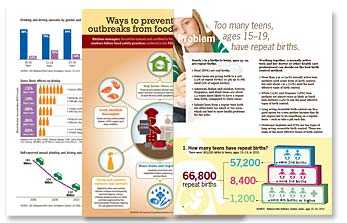Visual Communication Resources

Visuals can support the main message and help audiences understand numerical information.
Visuals, such as pictures, drawings, charts, graphs and diagrams, can be effective tools for communicating health information. Visuals can make the presentation of complex information easier to comprehend, more attractive, and can also reinforce written or spoken health messages.
Visual communication can benefit all audiences, but can be especially helpful to individuals with lower literacy and numeracy skills. Remember, though, that visuals can’t speak for themselves. People can interpret visuals, just as they do words, in different ways. Choose visuals that support the main message and have clear headings, labels, and captions.
Below are several resources for public domain health pictures, as well as resources that will help you make decisions about choosing images that effectively communicate your message and graphic displays your audience will understand.
- Public Health Image Library (Centers for Disease Control and Prevention 2008)
- Visuals Online (NIH National Cancer Institute)
- Making Data Talk [2 MB, 52 page] (NIH National Cancer Institute)
- Visualizing Health (University of Michigan)
- Icon Array (University of Michigan)
- Teaching Patients with Low Literacy Skills (see Chapter 7: Visuals and How to Use Them)
- Page last reviewed: June 23, 2014
- Page last updated: June 23, 2014
- Content source:
Error processing SSI file


 ShareCompartir
ShareCompartir